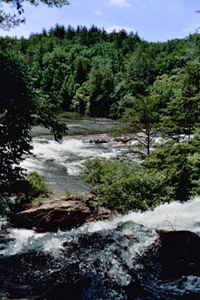Deliverance | 1972


- Locations |
- Georgia; South Carolina
- DIRECTOR |
- John Boorman
It turns out not to be a good weekend when four friends from Atlanta set out to canoe a rugged and remote stretch of water before it’s drowned forever by the construction of a new dam. What's more disturbing, the backwater nightmare that the four city guys find themselves in, or the fact that the movie generated a whitewater tourist boom in the area it was filmed? It goes to show that there’s no such thing as bad publicity.
In fairness, the canoeing is thrilling and – despite the best efforts of director John Boorman and cinematographer Vilmos Zsigmond to make the landscape less ‘pretty’ by desaturating the colour – the wild, unspoiled river looks stunning.

The film was made on location up in the northeastern corner of Georgia, around Rabun Gap and Clayton in Rabun County, towards the border with the Carolinas. The fictitious ‘Cahulawassee River’ down which Lewis (Burt Reynolds), Ed (Jon Voight) and co canoe is, for the most part, the Chattooga River, defining the state’s border with South Carolina, and flowing south into Lake Tugaloo.
The section of river used in the film is the roughly 10-mile stretch south from Earl’s Ford Road, running beneath Highway 76, Lookout Mountain Scenic Highway, to Lake Tugaloo itself.
Although the Chattooga has its share of famous rapids – which include Bull Sluice and Five Falls – the movie was filmed at the less well known Screaming Left Turn, Raven Rock and the striking geological formation now inevitably known as Deliverance Rock.
Apart from the river, Rabun County, offers miles of hiking trails, lakes and the Blue Ridge Mountains for those looking for a real outdoors experience.
If you’re thinking of visiting, there are two things to be aware of: the river was specifically chosen for its inaccessibility; and it’s not for the inexperienced canoeist. In the years following the release of the film, there were several fatalities among those who underestimated the water’s ferocity.

After the loss of one of their canoes and the mysterious death of Drew (Ronny Cox), the calmer stretch of water in which the remaining three find themselves is the spectacular Tallulah Gorge, downstream from Tallulah Falls. It’s here that Ed scales the sheer cliff face to confront the remaining mountain man.
The two-mile-long gorge, a couple of miles west of Tugaloo Lake, is a 1,000-foot deep chasm which, in 1992, became Tallulah Gorge State Park. You can hike rim trails to several overlooks, or you could get a permit to hike to the gorge floor (permits are not issued on some dates, due to water releases).
Since 2002, there’s a suspension bridge 80 feet above the rocky bottom, providing spectacular views of the river and waterfalls.
Famed tightrope walker Karl Wallenda, founder of The Flying Wallendas, probably got the best view of all when he crossed the Gorge on a high-wire in 1970. You’re probably better to content yourself with the historic Tallulah Point Overlook, open daily from 9am to 6pm, on Jane Hurt Yarn Road east of Hwy 441.
In a poignant echo of the film, the rising waters at the end of the film are Lake Jocassee, created when the Duke Power Company flooded Jocassee Valley in 1971. The lake is about 30 miles east of Clayton, over the border in Oconee County, South Carolina.
130 feet below its surface lies Mount Carmel Baptist Church Cemetery, the graveyard from which coffins are seen being moved.
The story was inspired by the flooding of the Coosawattee River, dammed in the 1970s to form Carters Lake. It’s southwest of Ellijay, over 50 miles to the west of the filming location. By the time the film came to be made, it was already too late to use the Coosawattee itself, as the trees had already been stripped from its banks.
• Many thanks to Georgia Department of Natural Resources for help with this section.





